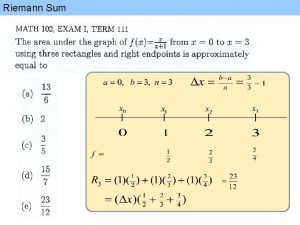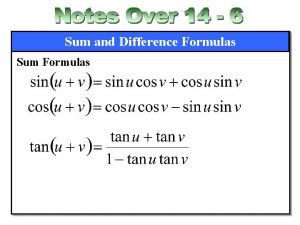Sum Check Where QuadraticPolynomials get slim 1 Introduction

![Introduction – Our starting point is a gap-QS instance [HPS]. – We need to Introduction – Our starting point is a gap-QS instance [HPS]. – We need to](https://slidetodoc.com/presentation_image_h2/c8309fbf1a8658955696dd075cd8d597/image-2.jpg)



![Partial Sums For any j [0. . d] let Sumƒ[j, a 1, . . Partial Sums For any j [0. . d] let Sumƒ[j, a 1, . .](https://slidetodoc.com/presentation_image_h2/c8309fbf1a8658955696dd075cd8d597/image-6.jpg)


- Slides: 8

Sum Check Where Quadratic-Polynomials get slim 1
![Introduction Our starting point is a gapQS instance HPS We need to Introduction – Our starting point is a gap-QS instance [HPS]. – We need to](https://slidetodoc.com/presentation_image_h2/c8309fbf1a8658955696dd075cd8d597/image-2.jpg)
Introduction – Our starting point is a gap-QS instance [HPS]. – We need to decrease (to constant) the number of variables each quadraticpolynomial depends on. – We will add variables to those of the original gap-QS instance, to check consistency, and replace each polynomial with some new ones 2

Representing Quadratic-Polynomial Representation of a polynomial P: P P(A) = i, j [1. . m] (yij) · A(yi) · A(yj) P(A) means estimating P at A(y ) is the Let A(yij) = A(y ) for i, j [1. . m] i (yiij)·A(y ) is the j a point assignment of coefficient Let A(y ) = 1 m 00 A=(a 1, …, am) ai to yi of the Then monomial yiyj P(A) = i, j [1. . m] (yij) · A(yij) 3

For any (i 1, . . . id) that Checking Sum overhas an no LDE yij-source, let’s define: l Let’s match a point in Hd for each variable ’(i 1, …, id)=A’(i 1, . . . id)=0 d yij: : {yij} H an LDE of d(or A) is of d l Let ’: H s. t. h=(i 1, …, id) H : ’(h)= ( degree |H|-1 in each -1(h)) variable, hence of total d: l Let A’: Hd s. t. h=(i , …, i ) H 1 dr = d(|H|-1). degree A’(h)=A( -1(h)) Therefore ƒ is of total Then P(A)= i, j [1. . m] (yij)·A(y h H ’(h)·A’(h) degree ij) = 2 r. l Let ƒ: be an LDE of ’·A’ Then we get: ƒ = LDE( )·LDE(A) P(A) = h H ’(h)·A’(h) = h H ƒ(h) 4

Each local-test accesses much smaller number than What’s Ahead |Hd| of representation variables, and a single Firstly, we show a test that, for any value of ƒ. assignment for which some variables corresponds to a function ƒ: of degree 2 r, verifies the sum of values of ƒ over Hd equals a given value. Secondly, we replace the assumption that ƒ is a low-degree-function by evaluating that single point accessed with an efficient consistent-reader for ƒ. 5
![Partial Sums For any j 0 d let Sumƒj a 1 Partial Sums For any j [0. . d] let Sumƒ[j, a 1, . .](https://slidetodoc.com/presentation_image_h2/c8309fbf1a8658955696dd075cd8d597/image-6.jpg)
Partial Sums For any j [0. . d] let Sumƒ[j, a 1, . . , aj](x) = hj+2, . . , hd H ƒ(a 1, . . , aj, x, hj+2, . . , hd). That is, Sumƒ is the function that “ignores” all indices larger than j, and instead sums over all points for which these indices are all in H. Proposition: Sumƒ is of degree 2 r Proof: ƒ is of degree 2 r, Sumƒ is a sum of degree-r functions 6

Properties of Sumƒ Proposition: For every a 1, . . , ad any j [0. . d] , ¶ h 1 H Sumƒ [0] (h 1) = i 1, . . , id H ƒ(i 1, …, id) · Sumƒ [d-1, a 1, . . , ad-1 ] (ad) = ƒ(a 1, . . , ad) ¸ j, Sumƒ [j, a 1, . . , aj] (aj+1) = h HSumƒ [j+1, a 1, . . , aj+1] (h) Now we can assume Sumƒ to be the point evaluation of some degree 2 r function (and later plug in a consistent-reader) and verify property 2, namely that for j=0, Sumƒ gives 7

Using consistent reader we lower the The Sum-Check Test degree to a constant, q Hence we have a test that uses only a Representation: constant number of variables. One variable [j , a , . . , a ] for every q 1 d a 1, . . , ad and j [0. . d] Supposedly assigned Sumƒ (j, a 1, . . , ad ) (hence ranging over ). Test: One local-test for every a 1, . . , ad that accepts an assignment A if for every j [0. . d], A( [j, a 1, . . , ad]) = = i HA( [j+1, a 1, . . , aj, i, aj+2, . . , ad])8















